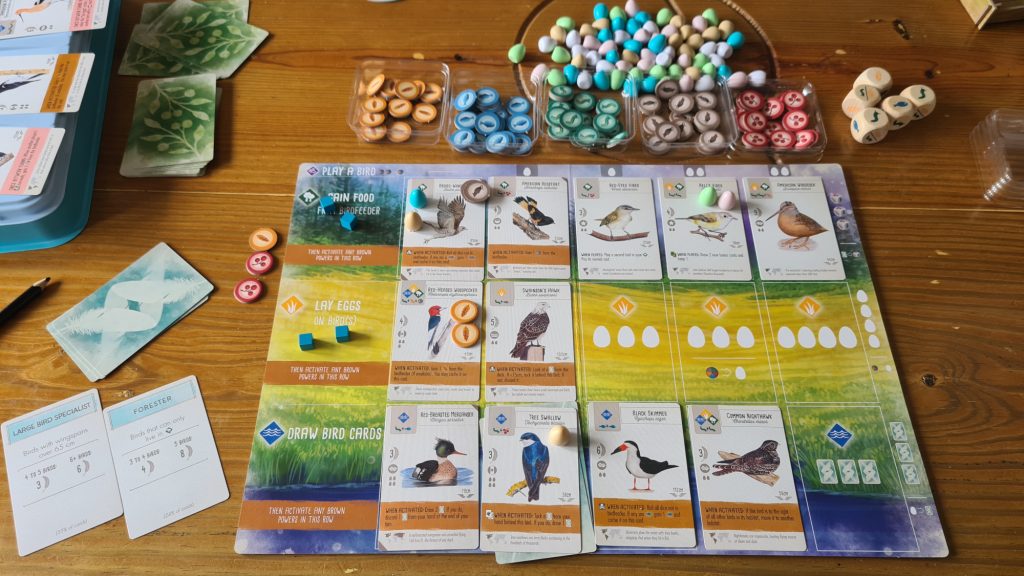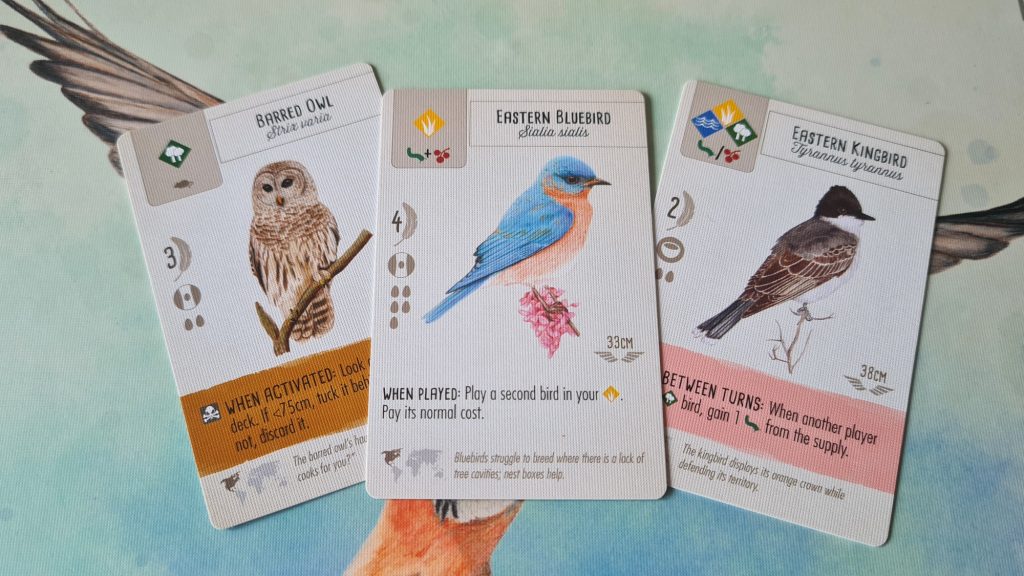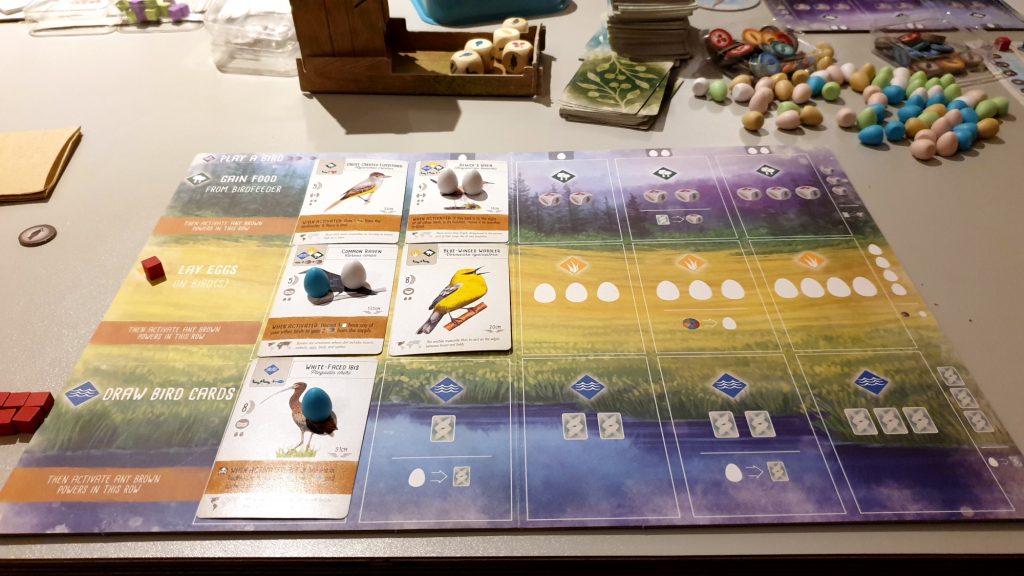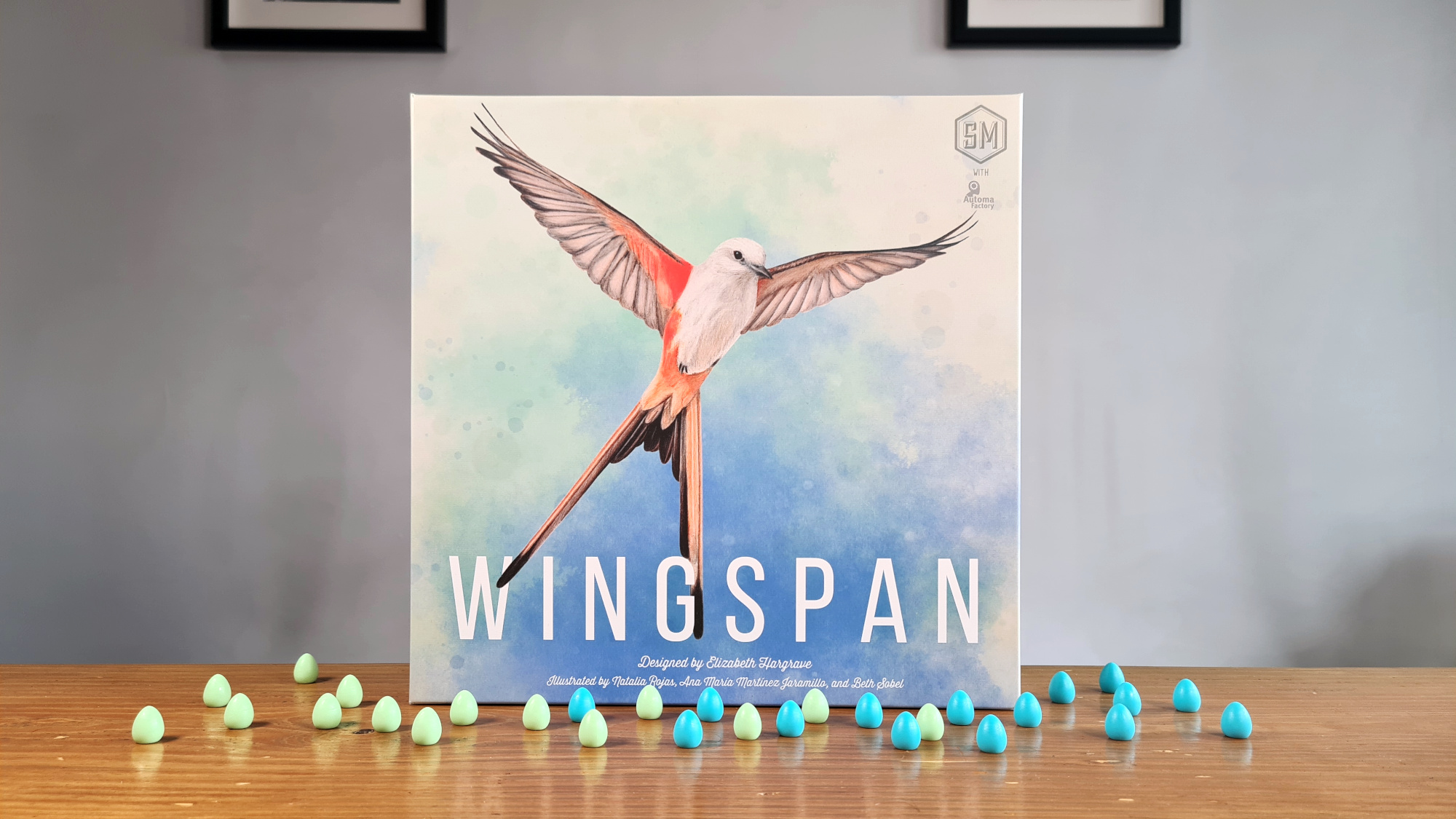Wingspan is a bird themed, tableau building, board game from publisher Stonemaier Games. Designed by Elizabeth Hargrave, featuring artwork from the likes of Beth Sobel and Ana Maria Martinez Jaramillo, the game sees 1 – 5 players attract birds to their wildlife reserve. Lasting around an hour, players will use invertebrates, seeds and more to attract birds and have them lay eggs across a variety of nest types. However, is Wingspan an egg-cellent experience or a fowl one? Let’s find out!
Setting up Wingspan is slightly different for the initial play, using predetermined components. This setup effectively removes some of the choices offered to players, when they aren’t accustomed to what would be good to take or not. This gives each player 2/3 specific bird cards and then 3/2 predetermined bits of food. In future games players will get 5 random bird cards and 1 food token of each type, having to keep 5 things in total. Players are then dealt two secret bonus cards, keeping one and discarding the other. With 4 round goal tokens randomly selected, eggs poured into the middle of the table, dice rolled through the birdfeeder and the market of bird cards created, Wingspan is then ready to be played!
Wingspan is played out over 4 rounds, with players taking 8 turns in the first round – reducing by 1 turn each round. Instinctively, players will think they will therefore be able to do less and less, yet as actions are sort of upgraded they can end up doing much more in later rounds. There are four actions a player can take on their turn, choosing from: Play a bird, gain food, lay eggs, and draw bird cards.
Playing birds means to add a card from your hand onto your personal board. Birds can’t just be played anywhere, often denoting forest, grassland or wetland as where they can be played – which just happens to be the three rows on the player boards. The first bird played to each of these habitats costs the food shown on the card, with future cards also coming with an egg cost. Costing food tokens and potential eggs to play a card shows the way that the four actions overlap. If the bird has a When Played ability it activates, potentially seeing the player able to play another bird or gaining an extra bonus objective.

The other three actions are upgraded by playing birds. When choosing to gain food, lay eggs or take cards the player places their action cube onto the leftmost empty space of that action row. This is the performed action, before activating any bird cards in that row. When choosing to gain food the basic action sees the player claim one of the food dice from the birdfeeder, gaining the depicted food token. When a card has been played into the forest row this instead becomes gain 1 food die and the player can choose to discard a card from their hand to take an additional food die. When a second forest bird is played the leftmost space is simply to gain two food dice and so on, each time upgrading the action.
Laying eggs sees eggs of any colour placed onto birds, though each has its own capacity – denoted by eggs symbols on the bird card. What nest type the birds are in doesn’t matter for laying the eggs. Yet, some objectives are based on eggs laid by specifically nested birds. The lay eggs action is upgraded from lay two eggs to also include pay any food token to lay a third and so on. The final action is to gain cards, drawing from the face up market of three bird cards or off the top of the deck. This starts at drawing 1 card, upgrading to draw 1 and an additional one for discarding an egg and so on.
When activating an action row players also trigger, from right to left, any bird cards with When Activated abilities. These can see the dice not in the birdfeeder rolled to cache food onto bird cards, cards tucked underneath already played birds or even a bird moving from one row to another. A smaller selection of birds have Once Between Turns abilities, and as the name suggests these are triggered by actions taken by others between on their turns and not at this stage.
Once a player has taken an action play moves on clockwise around the table, until everyone has spent all of their action cubes. Players check the round objective. These can be anything from the number of birds played into the wetlands to eggs laid in ground based nests. The round objective board is double sided, with players able to choose between the more competitive who has the most and how many times has a player done the objective (up to 5 times). Importantly, players use one of their action cubes to mark the points they get from the round objective. Played out over 4 rounds the game plays the same, with everything from round objectives and bonus objectives to points from played birds and cached food tokens scoring points. The winner is whoever has the most points at the end of the game, with ties split via remaining food tokens.

Including starting player guides was extremely helpful for first time players, and improved the ease of teaching the rules. After your first game these “starter” birds can then just be shuffled into the deck. Thanks to having a coloured corners it’s fairly easy to search through the deck and find the starter cards for future games, when introducing the experience to others. As long as the new players don’t care too much about being railroaded in the first half of round 1, potentially going away from the round 1 objectives, it’s a simple and effective way to get playing faster!
Gamers will try to say it’s all about the game mechanics, substance over style. It is hard to look past the stunning production of Wingspan, from the glorious eggs (which aren’t edible despite looking like Mini Eggs) to the well designed UI across the cards. Trying to nitpick it is hard to fault the chunky dice and the clean minimalist look. About as bad as it gets are the 4 included pots for food resources, which are superb for storing the tokens in the box, until you realise there are 5 unique resources.
The birdfeeder dice tower is of decent quality cardboard. On top of the usage during the game, squeezing it into the box by half taking it apart may eventually lead to some visible wear and tear over time. The rest of the components will fare better. The artwork that adorns the cards is something special. Some may have preferred the art to include more of the environments but the minimalist design, not only highlights the bird, the white background makes for a striking card design.
The majority of the round scoring and hidden objectives have been made significantly easier via iconography. Many aspects of the birds, such as their wingspan, can go unnoticed until an objective card mentions them. With objectives and bonuses revolving around anything from nest types to if they eat rodents, players can build very different engines each time they play and instantly recognise what their aim is.

As the game progresses players get fewer action cubes to use each round. Counterintuitively the players will be doing more though, as their played birds will activate when they take actions, creating bigger turns, and the actions themselves will be bigger. Especially with the way that the When Activated abilities work, there is plenty of opportunity to combo, making turns feel more impactful. All of a sudden that action to gain 1 food die becomes a flood of food and point scoring opportunities, and this turns the basic resource gaining turns into something players look forward to doing. No longer is getting the resources to play birds a lull.
The pink coloured Once Between Turns bird abilities can feel weak at 2 – 3 players. They are the sort of card you want to build early to maximise their return but then if they don’t have any early return it can feel like you are getting behind others who are triggering other actions consistently. As the player count increases the chance of these triggering increases, and then they become stronger. Another issue is that despite many routes to victory, the end of the game can become a bit of an egg spam. As every egg you have on birds scores points, and numerous round objectives feature eggs, the final turn or two can sometimes be spent just placing eggs onto birds. Players of course need room for those eggs but when the round objectives incentivise non-egg tasks the differing routes to victory seem more balanced.
Stonemaier Games’ titles are often majorly hyped and that was the case for Wingspan. Some of the flak the game has received has been due to this hype, making the game out to be more than it is. Go into Wingspan expecting a solid engine builder with plenty of choices and incredible production quality and you won’t be disappointed! Eggs do seem strong but the game does a great job of pulling players away from it, making them want to play that extra bird or trigger those abilities one more time.
While bird watching might not be the theme many would run towards, it is well used throughout the experience and can be celebrated as a non-violent theme that breaks the mould of what is normally seen. Wingspan is full of little important choices, with the fun of building up habitats full of birds. It’s rightfully seen as a game that can interest gamers and non-gamers alike, and that is why it has thoroughly earnt it’s spot on my gaming shelf!
(Editor’s Note: Wingspan was provided to us by Asmodee for the review. The game is currently available from local board game stores! Find your local store here.)

